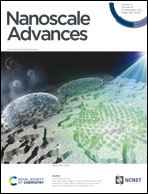Monolayer H-MoS2 with high ion mobility as a promising anode for rubidium (cesium)-ion batteries†
Abstract
Secondary ion batteries rely on two-dimensional (2D) electrode materials with high energy density and outstanding rate capability. Rb- and Cs-ion batteries (RIBs and CIBs) are late-model batteries. Herein, using first-principles calculations, the potential performance of H-MoS2 as a 2D electrode candidate in RIBs and CIBs has been investigated. The M-top site on 2D H-MoS2 possesses the most stable metal atom binding sites, and after adsorbing Rb and Cs atoms, its Fermi level goes up to the conduction band, indicating a semiconductor-to-metal transition. The maximal theoretical capacities of RIBs and CIBs are 372.05 (comparable to those of commercial graphite-based LIBs) and 223.23 mA h g−1, respectively, due to the strong adsorption capability of H-MoS2 for Rb and Cs ions. Noticeably, the diffusion barriers of Rb and Cs on H-MoS2 are 0.037 and 0.036 eV, respectively. Such a low diffusion barrier gives MoS2-based RIBs and CIBs high rate capability. In addition, H-MoS2 also has the characteristics of suitable open-circuit voltage, low expansion, good cycle stability, low cost, and easy experimental realization. These results indicate that MoS2-based RIBs and CIBs are innovative batteries with great potential, and may provide opportunities for cross-application of energy storage and multiple disciplines.



 Please wait while we load your content...
Please wait while we load your content...